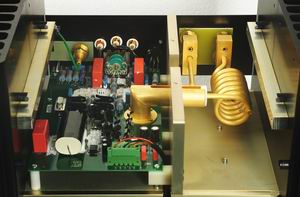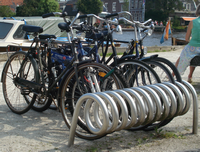My only concern with Torroids is potential saturation and non- linearty.
I suspect you didn't read my post.
...air core toroids...
Or?
Best wishes
David
second last table.Not to drag this out any longer, but which of these most closely resembles "lightning conductor"?
Lightning Conductors and Copper Cables - Series 100- Lightning Rod Parts
"SOLID COPPER & ALUMINUM STRIPS AND BARS"
These solid bars (often 25mm by 3mm) are what I see running down buildings and and have seen being installed under the ground connecting the Earthing pits.
Welded at junctions with a "thermite" style kit/jig.
Last edited:
I suspect you didn't read my post.
Or?
Best wishes
David
Ahh - apologies - I did not.
Hi Bob,
When talking about output chokes, they do relate to speaker wire as they are in series. Then there are the speaker crossovers to deal with. In comparison, that little choke doesn't seem to be a massive problem. The issue has to be kept in perspective at the end of the day. However, let's continue investigating as we may find out something unexpected.
Yes. At least you can't saturate an air coil.
Yes, and that is how we got off-track. This question is tied to contact resistance and wire resistance as well as skin effect. I don't know how you would come to an answer without considering these other things.
Self support and good heat conduction if it's an issue. Then there is the entire resistance question as you have pointed out.
Again we have to compare this effect to the rest of the circuit. Speaker wire and crossovers.
Resistance and dissipation are tied to wire size. Current density will give rise to temperature increases, so you can't talk about one thing in isolation I don't think. Not unless you want to hit the market with "Cryo-coils" that come with Dewar full of liquid nitrogen. It would probably become a high-end fad. I wonder, would "Cryo-Cable" shatter if it's stepped on?
Sorry Bob, it's late and I'm a little punchy.
-Chris
Hi Chris,
Yes, we always must keep things in perspective, and the minimum reasonable voice coil or load resistance is certainly important here.
However, looking at other imperfections in the path after the amplifier is not useful, as those elements may be all over the place in their characteristics. In other words, their imperfections do not justify any complacency in evaluating output coils.
The matter of heat in the real world and under conditions of listening to music is probably not an issue, as the average music power will be far less than the maximum power rating of the amplifier. However, we must at least be able to safely handle full power for bench testing.
Cheers,
Bob
That lightening cable looks pretty heavy.
For me, I just got some arc welding cable.
Also used it as a ground for my car,
ran it from back from common battery
terminal, to common point on the fire wall,
then had equal lengths running to each
cylinder head. Old Chevy has never
run so good.
Now looking for a bit more power,
plus another 150 to 200 HP and same Torque,
hoping for about 680-700 lb/ft at a
wide 3000 RPM curve. : )
For me, I just got some arc welding cable.
Also used it as a ground for my car,
ran it from back from common battery
terminal, to common point on the fire wall,
then had equal lengths running to each
cylinder head. Old Chevy has never
run so good.
Now looking for a bit more power,
plus another 150 to 200 HP and same Torque,
hoping for about 680-700 lb/ft at a
wide 3000 RPM curve. : )
Toroids should be superior in this, and equal or better in other metrics, problem solved I think.
I have test wound a few and plan to use them in the next amp, have you considered them?
Best wishes
David
Hi Dave,
Yes, toroids have good potential. I used air core toroid output coils in my Super Gain Clone amplifier. They were about 3uH. They were fairly large, however. I think I wound them with #18 on a pencil, then took the coil off and formed it into a toroid.
Cheers,
Bob
Hi Edmond
Doesn't the one in the Halcro look a bit like that?
It's nicely sculptural, but air core toroids are too.
And I plan to counter-wind a second helix to cancel the poloidal fields.
Should look "hi-tech sculpture" and it really has a function, not just phoney pseudo tech.
Haven't actually optimised it yet, I suspect it's very broad optimum so I haven't searched much or done maths.
You (or anyone) seen any data on best toroid proportions?
Best wishes
David
Yes, the Halcro coil looks like that; huge and not close-wound. Low coil efficiency and a huge electromagnetic footprint.
Cheers,
Bob
IIRC, the optimal 'single' or thin layer toroid has OD = 2 x ID.You (or anyone) seen any data on best toroid proportions?
And yes, the optimum is very wide.
I remember a pic of a Halcro output inductor fenced off in its own rectangular metal walled subsection of the case
reminded me of: https://www.jlab.org/accel/inj_group/docs/Coaxial_Resonators.pdf
reminded me of: https://www.jlab.org/accel/inj_group/docs/Coaxial_Resonators.pdf
That was with their second design...

An externally hosted image should be here but it was not working when we last tested it.
Hi Bob,
I agree, not being complacent about it. I just wanted to prevent some folks from designing around this one idea and forgetting the rest of the story.
That Halcro output inductor in it's cell is reminiscent of an RF amplifier output. So that's where all the money went!
-Chris
I agree, not being complacent about it. I just wanted to prevent some folks from designing around this one idea and forgetting the rest of the story.
That Halcro output inductor in it's cell is reminiscent of an RF amplifier output. So that's where all the money went!
-Chris
Hi Bob,
I agree, not being complacent about it. I just wanted to prevent some folks from designing around this one idea and forgetting the rest of the story.
That Halcro output inductor in it's cell is reminiscent of an RF amplifier output. So that's where all the money went!
-Chris
I don't see the shunt resistor.
Cheers,
Bob
That lightening cable looks pretty heavy.
For me, I just got some arc welding cable.
Also used it as a ground for my car,
ran it from back from common battery
terminal, to common point on the fire wall,
then had equal lengths running to each
cylinder head. Old Chevy has never
run so good.
Now looking for a bit more power,
plus another 150 to 200 HP and same Torque,
hoping for about 680-700 lb/ft at a
wide 3000 RPM curve. : )
Turbo!
But yeah, sometimes the ground paths in cars aren't so good, and get worse with age. Probably radiates less RFI, too.
Though in many respects the Quad 405 is not a standard amplifier design it does use an output inductor. In the following article
http://ddata.over-blog.com/1/74/30/05/Docs/feedForward.pdf
There is discussion and measurments of 2 inductor constructions, about 1/3 down the left column with measurments shown Fig 10 page 13
Stuart
http://ddata.over-blog.com/1/74/30/05/Docs/feedForward.pdf
There is discussion and measurments of 2 inductor constructions, about 1/3 down the left column with measurments shown Fig 10 page 13
Stuart
IIRC, the optimal ... thin layer toroid has OD = 2 x ID.
When Bob first raised the topic I expected it to be fairly simple.
Now I have researched toroid optimization and found that it's not rocket science - it's more advanced than that
The maths turns out to be the same as for nuclear fusion reactor toroids, wonderful, and there's some nice results.
Not the same as your formula but you are correct that it's not very sharp peaked optimum.
So the technical improvement is small but think of the possibilities for advertisements.
Yes, the Halcro coil looks like that
Edmond's picture

has cleared up a mystery about the company name.
They must have found some surplus Hand Assembled Leftover Cycle Rack Output inductors.
Thanks that you raised the topic and made me learn a bit more.
Best wishes
David
Last edited:
When Bob first raised the topic I expected it to be fairly simple.
Now I have researched toroid optimization and found that it's not rocket science - it's more advanced than that
The maths turns out to be the same as for nuclear fusion reactor toroids, wonderful, and there's some nice results.
Not the same as your formula but you are correct that it's not very sharp peaked optimum.
So the technical improvement is small but think of the possibilities for advertisements.
Edmond's picture
has cleared up a mystery about the company name.
They must have found some surplus Hand Assembled Leftover Cycle Rack Output inductors.
Thanks that you raised the topic and made me learn a bit more.
Best wishes
David
That's so funny about the Halcro name!
I actually believe that it is Bruce Candy's middle name.
Cheers,
Bob
- Home
- Amplifiers
- Solid State
- Bob Cordell's Power amplifier book